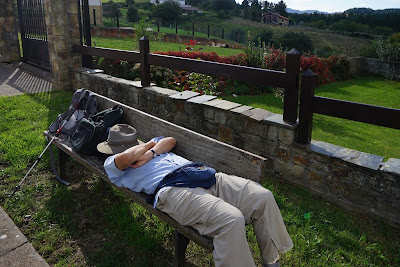It was the seat of power for a long time since the middle ages.
Now it represents the symbolic center of Basque people.
To the rest of the world, it likely means the title of Picasso's monumental painting, the subject of which being the infamous bombing and leveling of the city by the Nazis in 1937 at the behest of Franco.
A small town on the Camino has such history. With the expert help from the lady at the TI, we were able to fit all major sights into the 4 - 7 pm window yesterday. First, the Assembly House and the Gernika Tree. Then Peace Museum. Then Basque Country Museum. Then the Park of European Nations with sculptures by Henry Moore and Chillida. Then the copy of Gernika by Picasso. (This Basque spelling is what I will use from now on).
 |
| Gernika: a short introductory video at Casa de Junta (Assembly House) starts with acorn germination. It is all about oak trees! |
 |
| Gernika: Casa de Junta has hosted important meetings for the the Biscay region since 11th century, which resumed in 1979 after a century-long interruption. |
 |
| Gernika: the stained glass at Casa de Junta depicts an oak tree, under which important meetings were held, as well as towns in Biscay surrounding the tree. |
 |
| Gernika: "Old Trunk" - the retired (and deceased) tree, a grandfather to the current reigning tree |
 |
| Gernika: Peace Museum |
 |
| Gernika: Euskal Herria (Basque Country) Museum. Among the famous people of Basque origin are composers Sarasate and Ravel. |
 |
| Gernika: Park of European Nations. A Henry Moore. |
 |
| Gernika: A Chillida sculpture at Park of European Nations |
 |
| Gernika: the restaurant hours for dinner are late like in the rest of Spain, but a simpler meal is always easy to get. We went for pintxos right next to our hotel. |
The next stage on the Camino is Gernika to Lezama, which is again too long for us. During my preparation, the small town of Morga (Andra Mari in Basque) seemed to be an ideal stopping point. But there was no room available at the only hotel, and furthermore Morga was probably not directly on the Camino, which could present a problem. So we are going to "commute" from Gernika. Somehow I need to get from the Camino to this town, which was not clear on any of the maps. The person at the TI came to the rescue yesterday. The map she gave us shows a clear relationship between the Camino and Morga, and walking off the Camino two kilometers to Morga seemed reasonable. The receptionist at our pension helped arrange a taxi to pick us up at Restaurant Katxi in Morga, and we are all set.
We say good bye to Sunjin over breakfast - she is taking the train to Bilbao and from there to Madrid and back to Korea. As we leave town, we again run into the Korean school group. They are staying an extra day here and able to see the sights in this town today.
 |
| Gernika: runners in a half marathon from Bermeo to Gernika are arriving at the main square as we set out to walk on the Camino. |
 |
| The first part of today's walk is a continuous climb. I feel sorry for the occasional cyclist who pedals up a steep rocky hill. |
 |
| But these kids are doing really well. |
 |
| Morga: this plate is called the Lezama style salad? Maybe this is a preview as Lezama is our next stop. These taste so good that even I, not a lover of tomatoes, finished my portion. |
 |
| Morga: squid in black ink (txipirones en su tinta) |
 |
| Back in Gernika: rising over the church, it is not just the full moon. And it is more than the harvest moon. It is the super moon but not quite the blood moon. |






No comments:
Post a Comment